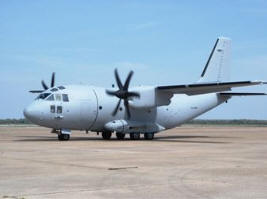
NEWSROOM
 |
NEWSROOM |
|
|
|
||||
|
By Ellen Krenke |
||||
 |
November 3, 2009 -
"It is the first
time in U.S. Air Force history where the service acquired a new airframe
solely owned, operated and maintained by the Air National Guard," said
Lt. Col. Chris Beckman, the ANG's aviation planning and execution chief.
C-27J Spartan is a
medium-sized military transport aircraft. The C-27J is an advanced
derivative of Alenia Aeronautica's G.222 (C-27A Spartan in The C-27J Spartan, the latest propeller-driven airlifter, is an "extremely rugged" aircraft, designed for austere environments, said Air Force officials. It is about half the size of a C-130 Hercules and has 3.5 cargo pallet positions. |
|||
| A C-27J Spartan taxis on the ramp at Redstone Arsenal, Ala., during flight testing in early 2009. Air Force officials plan to add 38 C-27Js to its inventory, which will be operated by the Air National Guard. | ||||
|
He added that flying fixed-wing aircraft is not the Army's core
competency.
|
||||
|
Two Army National
Guard units, Company H, 171st Aviation Regiment from
"The ANG has played a critical role in the development of the C-27J
roadmap to include basing, personnel, aircraft delivery, Air Force
instruction and technical order development and review, service transfer
and planning for operational execution," Colonel Beckman said.
In 1995, Alenia and Lockheed Martin began discussions to improve the
Alenia's G.222 using C-130J's glass cockpit with a more powerful version
of the G.222's T64G engine and four-blade propellers. The companies
began a program for the improved G.222, named C-27J in 1996. This was a
Alenia and Lockheed Martin formed Lockheed Martin Alenia Tactical
Transport Systems (LMATTS) for the development of C-27J in 1997. The
LMATTS joint venture was later dissolved when Lockheed Martin chose to
offer the C-130J as a contender in the same U.S. Army and U.S. Air Force
Joint Cargo Aircraft (JCA) competition in which the C-27J was competing.
Alenia Aeronautica then paired with L-3 Communications to form the
Global Military Aircraft Systems (GMAS) joint venture to market the
C-27J. Boeing Integrated Defense Systems later joined Alenia and L-3
Communications as a GMAS team member.
The C-27J has a 35% increase in range and a 15% faster cruise speed than
the G.222. The Italian Air Force, Hellenic Air Force, Bulgarian Air
Force, Romanian Air Force, United States Army and the United States Air
Force have ordered the C-27J. Alenia is offering
The GMAS team bid the C-27J in the Joint Cargo Aircraft competition
against Raytheon and EADS North America's C-295. Both the U.S. Army and
Air Force JCA orders combined are expected to top 100 aircraft. The JCA
will eventually replace the existing C-23 Sherpa, C-12 Huron and C-26
Metroliners in the Army National Guard, and will become a substitute
tactical airlift platform for those Air National Guard airlift groups or
airlift wings losing C-130E/H/J aircraft to retirement (C-130E) or Base
Realignment and Closure (BRAC) action redistribution of aircraft
(C-130H/C-130J).
The C-27J had completed the U.S. Department of Defense's Early User
Survey evaluations by November 2006, flying 26 hours and surpassing all
the JCA program requirements. The GMAS team also announced that the
C-27J will be assembled at a facility at Cecil Field,
On 22 June 2007, Raytheon formally protested the award of the JCA
contract to the Alenia C-27J. On 27 September 2007, the GAO announced
that it had denied Raytheon’s protest, thereby allowing the Pentagon to
go ahead with the C-27J procurement. Prior to Raytheon's protest, the
first C-27J aircraft were to begin delivery to the joint US Army-Air
Force test and training program in June 2008. The first flight of a US
C-27J occurred on 17 June 2008.
The C-27J was being considered as a sole-source contract by the
Government of Canada as a future replacement for its current search and
rescue airfleet, the contract being worth approximately C$3 billion as
of January 2007.
The C-27J is a probable contender for a Royal Australian Air Force
requirement for light airlifer to replace its aging DHC-4 Caribou.
The US Air Force is shifting US$32 million from the Pentagon's 2008
budget to purchase a C-27J for the Air Force Special Operations Command.
The AC-27J will be equipped using proven hardware and systems to reduce
risk.
On 13 November 2007, the first C-27J was delivered to the Bulgarian Air
Force.
The
The Canadian Forces Air Command has identified the C-27J as one of two
candidates to replace the de Havilland Canada DHC-5 Buffalo and would be
purchasing 15 aircraft.
It was announced on 21 August 2009 that |
| ©AvStop Online Magazine Contact Us Return To News |